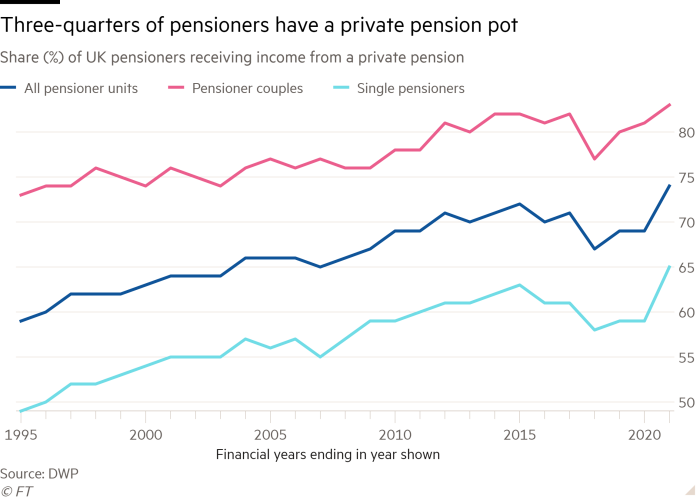If you’ve saved for retirement for much of your life and accumulated a decent pot, you might think your pension planning days are over.
Not at all. The decisions about how much money to take out — and when — have long been fraught. Nobody knows how many years of life or good health they might have, let alone what financial pressures they might face, from an expensive building job or an unexpected request from a cash-strapped child to social care.
Now the cost of living crisis has made things worse, and less predictable. Older people, whether in retirement or in the last years before stopping work, are confronted with extra financial headaches, starting with soaring household bills.
For those with investments, last year’s financial market turmoil sliced value from both bonds and equities — the classic components of a retirement portfolio — increasing the risk that retirees outlive their savings.
Certainly, interest rates have jumped, from below 1 per cent on cash savings in 2021 to over 4 per cent today, generating useful extra income for the many older Britons holding cash. But with UK inflation at 10 per cent, the real return is much lower than a year ago.
All this complicates the decisions those planning retirement or already in retirement make around how to draw down — that is take money out of their pension pot, either in lump sums or as income.
Becky O’Connor, head of public affairs at pension provider PensionBee, says: “At the best of times, with imperfect information about the future . . . it’s very hard to calculate what is a sensible amount of money to take as income drawdown from a pension.
“But these are not the best of times. If you add in higher-than-normal inflation and unstable pension pot values to this already tricky equation, identifying a sustainable withdrawal rate becomes a bit like pinning the tail on the donkey.”
FT Money looks into how best to navigate this financial minefield.

Raiding the pension pot
While many poorer pensioners lack any kind of savings, 74 per cent now have a private pension pot, according to government data for 2021. Most are in defined contribution pensions, where they have to manage drawing an income on their own.
The declining numbers fortunate to be in defined benefit (DB) pensions will have guaranteed income in place. But they too have choices — notably they can, like defined contribution (DC) scheme members, take out a tax-free lump sum of 25 per cent of their pot. To complicate things further, some people have both types of pension.
Especially for DC pension holders, the drawdown decisions can be crucial, and make the difference between comfort, getting by and poverty.
Richard Hulbert, insight consultant for wealth and protection at Defaqto, explains: “The cost of living crisis means that many in drawdown will need their savings to produce more income than last year. However, the savings producing the cash will largely have decreased in value over the past year due to market conditions and an income having been taken from it.
The alternatives are stark, he says. “The main options are: decrease or suspend the income being taken, or take more investment risk. In reality, neither feels like a palatable option.”
After the pandemic disrupted the economy of many household finances, more people than ever are facing this dilemma. The total number of pension plans accessed for the first time increased by 18 per cent to 705,666 in 2021-22 compared with 2020-21 (596,080), according to the latest Financial Conduct Authority data. With UK inflation rising further in the financial year starting in April 2022, the pressure on older householders has only worsened, and with it the need to take more out of pension pots.
The figures do not cover those who had already accessed their pots and are now increasing what they draw down.
It’s not only retirees making painful adjustments. Some older workers are under such pressure that they are taking money out of pension funds for current spending. Tom Selby, head of retirement policy at investment platform AJ Bell, says: “Among those aged 55 or over who are still working, we will inevitably see more people turning to their retirement pot earlier than planned.”
Advisers are reporting more clients in drawdown — typically pensioners now using up their retirement funds — are reconsidering their plans. Will Stevens, head of financial planning at wealth manager Killik & Co, says it’s a combination of “delaying their intended plans, cutting back on the income they are taking, and assessing whether their lifestyles will still be viable.”

Don’t draw down too much too early
A big danger is taking out too much money early in retirement. This reduces the value of the portfolio and so the future income it can generate, not least in a financial market shock, like last year.
Ian Millward, director of Candid Financial Advice, says: “It is like compounding in reverse. Once you get behind, the maths are against you, and it becomes ever harder to recover. For example, a 10 per cent fall needs an 11.11 per cent bounce and a 20 per cent fall needs a 25 per cent recovery. Keeping a healthy cash float and not drawing too heavily when markets are down are both essential for long term success.”
Martin Ansell, pension expert and chartered insurer at NFU Mutual, says the problem is compounded by people drawing too much income. More than half of 55 to 64-year-olds using income drawdown withdrew 6 per cent or more from their pot in 2021-22. And data from the FCA shows 40 per cent of regular withdrawals were withdrawn at an annual rate of over 8 per cent of the pot value.
That’s much higher than the common rule of thumb that 4 per cent taken from the pension, and then increased each year with inflation, is a sustainable withdrawal rate. Under the ultra-low interest rates that prevailed for a decade until last year, cautious advisers even argued for 3 per cent.
Steve Webb, partner at consultants LCP, says: “The 4 per cent rule is now nearly 30 years old and was based on US data and market conditions at the time. In September 2020 we argued that ultra-low interest rates meant that a ‘3 per cent rule’ was likely to be more appropriate.
“But the world has changed considerably since then, and a withdrawal rate of 4 per cent or more may well turn out to be sustainable now.”
However, others think 4 per cent is still too aggressive, given the market turmoil. Andrew Megson, executive chair of My Pension Expert, a financial planner in Doncaster, says: “We are far more comfortable with 3 per cent and the ability for the portfolio to grow.”
Dividing your pot into buckets
Advisers use various investment strategies during the years of withdrawals: income driven, which means taking out only the naturally occurring income from interest or dividend yield; total return, which draws from capital growth and naturally occurring income; and the bucket approach which reflects tailoring strategy to changing needs over retirement.
Bucketing involves dividing your portfolio into investments with different risk levels targeting your short-, mid- and long-term requirements. Kevin Hollister, director of retirement planning website Guiide.co.uk, says: “If you look at a typical retiree’s spending it will increase up to, say, 75 and then fall in real terms as you become less active over time. In much later life — 85-plus — you may want it to increase again to make sure it keeps pace with essentials.
“You can get more starting income, with the same sized pot, with this shape income than with one that increases every year, which you probably won’t spend in later life.”
Wealthy people who can afford to leave their capital intact and are planning their legacies are often encouraged to take only the income. Firmly in this “natural yield” corner is Doug Brodie, chief executive of Chancery Lane, a retirement income advisory service, who says: “The volatility in the current market is in the price of assets, and those who have income-producing assets — such as preference shares or investment trusts — will have noticed no volatility in the income.”
But Stevens warns: “By focusing solely on the income element, you can limit the universe of investments you might pick from. It may leave you vulnerable to volatility that you may not have otherwise experienced with a diversified portfolio.”
Moreover, there is a big advantage to limiting drawdown from a DC pension pot: it can be passed free of inheritance tax to heirs, unlike most other savings funds. Also, advisers point out that where investors have additional assets outside a pension pot or Isa, a total-return strategy enables use of additional tax allowances. This includes using annual exempt amounts for capital gains tax, on top of dividend and income tax allowances.
Gain time by holding cash
Meanwhile, there is one benefit to savers in last year’s market turmoil — increased returns on cash.
By holding some cash, with 4 per cent interest rates now available, you can reduce the risks of having to draw on stock and bond investments when markets fall. Some advisers suggest holding 12 months to two years basic expenditure in cash, while others allocate a percentage, say 15 per cent of a portfolio. Millward says: “Cash buys you time and emotional comfort during the tough times.”
The rise in rates has also given new life to annuities, products providing a guaranteed income until death. In December 2022, £100,000 could buy a 65-year-old an annual income of £7,144, compared with an all-time low of £4,696 in August 2016, according to website Sharing Pensions.
But buying an annuity usually means taking on inflation risk. Megson warns: “Index-linked annuities are very expensive but inflation at 10 per cent will erode the value of a level annuity very quickly.”
Bearing this in mind, a flex first, fix later strategy can make sense. Webb says: “For many people, a good strategy will be to continue to seek investment growth in a more flexible early stage of their retirement before locking in to the security of an annuity in later retirement.”
But as annuities die with you, they may remain unpopular for wealthier retirees. O’Connor says: “The gains you can make over years invested can amplify your pot size not just for your own retirement income, but allowing you potentially to leave more to relatives.”
Lump sums: don’t be overgenerous
It’s common for wealthier people to draw large lump sums at retirement to help out family members. A 25 per cent tax-free pension lump sum can seem like an obvious fund to draw upon as you often have access to it when adult children are approaching the first rung of the housing ladder.
But the risk in using your pension pot to give large amounts to your children or grandchildren is that in your generosity, you forget to leave enough to look after yourself in your old age. Clearly, some may underestimate their life expectancy, and therefore their future needs. Colin Low, managing director of financial planner Kingsfleet Wealth, says: “People don’t think ahead far enough and what they have left may not last.”
Others may regard their own homes as the ultimate financial safety net, but overestimate how quickly or efficiently they can downsize in late retirement, particularly in a tricky housing market.
Before you make an offer, make sure you have enough left over after the gift to sustain the annual income you think you’ll need, ideally until well into your eighties. You might also want to bear in mind future gifts to other children or grandchildren.
O’Connor says: “In difficult economic times, it’s sensible to err on the pessimistic side of what is an affordable amount for you to offer. If things change, perhaps you can gift more later.
“It might not feel like enough or as much as you would like to give, but think of pension pots as life jackets — you need to keep yours on if you want to help others.”
‘You cut your cloth to fit your income’
Diane Dean is 80 and went into drawdown in 2013, which she says has been “a very favourable experience”. At first she and her husband, who is 81, drew down in lump sums but they moved to taking a regular income on the advice of their independent financial adviser, Candid Financial Advice.
“Each year the income has increased a little bit, though this year I think it might not. I don’t keep a regular eye on the state of my pension fund — I don’t think it’s a good idea. I took an interest in the recent stock market falls, but history tells us that it recovers eventually,” she says.
She is sanguine about inflation and the cost of living crisis. “It’s alarming how much food has gone up but you just cut your cloth to fit your income. We have reduced our heating usage by switching to manual timings and try to use the car less too.
“I don’t worry about running out of money. We’ve always got the house and I’m not concerned about leaving money for the children. We have already done some downsizing with property.”










